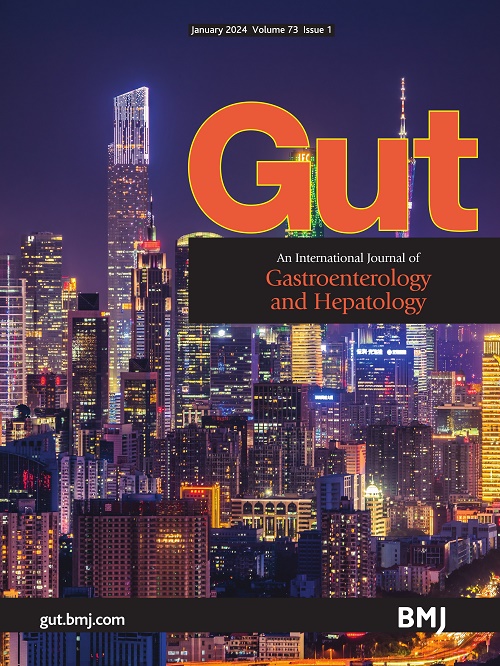Bioprinting functional hepatocyte organoids derived from human chemically induced pluripotent stem cells to treat liver failure
IF 23
1区 医学
Q1 GASTROENTEROLOGY & HEPATOLOGY
引用次数: 0
Abstract
Background To treat liver failure, three-dimensional (3D) bioprinting is a promising technology used to construct hepatic tissue models. However, current research on bioprinting of hepatic tissue models primarily relies on conventional single-cell-based bioprinting, where individual functional hepatocytes are dispersed and isolated within hydrogels, leading to insufficient treatment outcomes due to inadequate cell functionality. Objective Here, we aim to bioprint a hepatic tissue model using functional hepatocyte organoids (HOs) and evaluate its liver-specific functions in vitro and in vivo . Design Human chemically induced pluripotent stem cells (hCiPSCs) were used as a robust and non-genome-integrative cell source to produce highly viable and functional HOs (hCiPSC-HOs). An oxygen-permeable microwell device was used to enhance oxygen supply, ensuring high cell viability and promoting hCiPSC-HOs maturation. To maintain the long-term biofunction of hCiPSC-HOs, spheroid-based bioprinting was employed to construct hepatic tissue models (3DP-HOs). 3DP-HOs were intraperitoneally implanted in mice with liver failure. Results 3DP-HOs demonstrated enhanced cell viability when compared with a model fabricated using single-cell-based bioprinting and exhibited gene profiles closely resembling hCiPSC-HOs while maintaining liver-specific functionality. Moreover, 3DP-HOs implantation significantly improved survival in mice with CCl4-induced acute-on-chronic liver failure and also Fah−/− mice with liver failure. 3DP-HOs significantly reduced liver injury, inflammation and fibrosis indices while promoting liver regeneration and biofunction expression. Conclusion Our bioprinted hepatic tissue model exhibits remarkable therapeutic efficacy for liver failure and holds great potential for clinical research in the field of liver regenerative medicine. All data relevant to the study are included in the article or uploaded as supplementary information.生物打印人类化学诱导多能干细胞衍生的功能性肝细胞类器官治疗肝衰竭
为了治疗肝功能衰竭,三维生物打印是一种很有前途的技术,用于构建肝组织模型。然而,目前关于肝组织模型生物打印的研究主要依赖于传统的单细胞生物打印,其中单个功能性肝细胞分散并分离在水凝胶中,由于细胞功能不足导致治疗效果不足。目的利用功能性肝细胞类器官(HOs)生物打印肝脏组织模型,并在体外和体内评价其肝脏特异性功能。人类化学诱导多能干细胞(hCiPSCs)作为一种强大的、非基因组整合的细胞来源,被用于产生高存活率和功能性的多能干细胞(hCiPSCs -HOs)。采用透氧微孔装置增强供氧,确保高细胞活力,促进hCiPSC-HOs成熟。为了维持hCiPSC-HOs的长期生物功能,采用球形生物打印技术构建肝组织模型(3d - hos)。将3d - hos腹腔植入肝功能衰竭小鼠。结果与单细胞生物打印模型相比,3d打印hos显示出更高的细胞活力,并显示出与hCiPSC-HOs非常相似的基因谱,同时保持肝脏特异性功能。此外,3d - hos植入可显著提高ccl4诱导的急性慢性肝衰竭小鼠和Fah - / -肝衰竭小鼠的存活率。3d - hos可显著减轻肝损伤、炎症和纤维化指标,促进肝再生和生物功能表达。结论生物打印肝组织模型对肝功能衰竭具有显著的治疗效果,在肝再生医学领域具有广阔的临床应用前景。所有与研究相关的数据都包含在文章中或作为补充信息上传。
本文章由计算机程序翻译,如有差异,请以英文原文为准。
求助全文
约1分钟内获得全文
求助全文
来源期刊

Gut
医学-胃肠肝病学
CiteScore
45.70
自引率
2.40%
发文量
284
审稿时长
1.5 months
期刊介绍:
Gut is a renowned international journal specializing in gastroenterology and hepatology, known for its high-quality clinical research covering the alimentary tract, liver, biliary tree, and pancreas. It offers authoritative and current coverage across all aspects of gastroenterology and hepatology, featuring articles on emerging disease mechanisms and innovative diagnostic and therapeutic approaches authored by leading experts.
As the flagship journal of BMJ's gastroenterology portfolio, Gut is accompanied by two companion journals: Frontline Gastroenterology, focusing on education and practice-oriented papers, and BMJ Open Gastroenterology for open access original research.
 求助内容:
求助内容: 应助结果提醒方式:
应助结果提醒方式:


